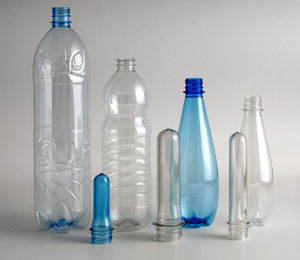BEVERAGE PACKAGING
PET increasingly sets the pace / Technology developments / Inroads into beer market
At just under 6 bn litres, 42% of all soft drinks sold in Germany were packaged in PET – this was an increase of some 250% over the 1.7 bn litres of non-alcoholic beverages that reached the country´s market in PET in 1998. Since then, the polymer has again increased its market share to more than 50%.
Over the past decade, the use of PET has spread into many new segments of the packaging market, from carbonated drinks to dairy products and into juices. It is even making inroads into the beer market, which traditionally favours glass bottles, overcoming the prejudices that the plastic may taint the flavour of the beer.
At the recent “interpack 2005” exhibition in Dusseldorf, there was great interest in technological solutions relating to the packaging material. One manufacturer is developing a technique to use polymer melt directly in turning out preforms, thus eliminating the use of granules in the manufacture of preforms and saving costs.
PET´s performance as a barrier against oxygen and carbon dioxide can cause problems. For example, because of the relatively large surface area, bottles with a small volume content are particularly affected. Additionally, the flavour intensity of products sensitive to oxygen, such as juice, dairy products or tea, diminishes within a relatively short period of time. Beer and wine suffer from the same problem.
There are a number of solutions that assist in improving the barrier properties of PET but none has really gained acceptance. New technologies, such as coating with silicon oxide generated from gaseous siloxanes through plasma treatment, are expected to increase barrier properties substantially.
Plasma impulse chemical vapour deposition (PICVD) is a process that applies extremely thin coats of silicon dioxide which is said to achieve previously unattainable barrier properties. Its use has already been approved by the US Food and Drug Administration (FDA).
An oxygen scavenging resin developed in Australia was used as a coating for the first time in Europe in 2004. The improved surface layer offers additional protection against delamination, benefiting both the appearance and the quality of the contents.
Barriers based on hydrogenated carbon, applied to the container´s internal wall, have been developed in France and are suitable for high-output bottle production. The barrier offers effective protection against oxygen and maintains carbonation in beverages.
The effects of UV radiation on PET packaging and some drinks are also being researched. Additives that block different wave lengths of UV light are available, and work is continuing on broadening the range of wave lengths that can be screened.
Over the past decade, the use of PET has spread into many new segments of the packaging market, from carbonated drinks to dairy products and into juices. It is even making inroads into the beer market, which traditionally favours glass bottles, overcoming the prejudices that the plastic may taint the flavour of the beer.
At the recent “interpack 2005” exhibition in Dusseldorf, there was great interest in technological solutions relating to the packaging material. One manufacturer is developing a technique to use polymer melt directly in turning out preforms, thus eliminating the use of granules in the manufacture of preforms and saving costs.
PET´s performance as a barrier against oxygen and carbon dioxide can cause problems. For example, because of the relatively large surface area, bottles with a small volume content are particularly affected. Additionally, the flavour intensity of products sensitive to oxygen, such as juice, dairy products or tea, diminishes within a relatively short period of time. Beer and wine suffer from the same problem.
There are a number of solutions that assist in improving the barrier properties of PET but none has really gained acceptance. New technologies, such as coating with silicon oxide generated from gaseous siloxanes through plasma treatment, are expected to increase barrier properties substantially.
Plasma impulse chemical vapour deposition (PICVD) is a process that applies extremely thin coats of silicon dioxide which is said to achieve previously unattainable barrier properties. Its use has already been approved by the US Food and Drug Administration (FDA).
An oxygen scavenging resin developed in Australia was used as a coating for the first time in Europe in 2004. The improved surface layer offers additional protection against delamination, benefiting both the appearance and the quality of the contents.
Barriers based on hydrogenated carbon, applied to the container´s internal wall, have been developed in France and are suitable for high-output bottle production. The barrier offers effective protection against oxygen and maintains carbonation in beverages.
The effects of UV radiation on PET packaging and some drinks are also being researched. Additives that block different wave lengths of UV light are available, and work is continuing on broadening the range of wave lengths that can be screened.
 | |
PET bottles and preforms (Photo: SIG Corpoplast)
16.06.2005 Plasteurope.com [202638]
Published on 16.06.2005
